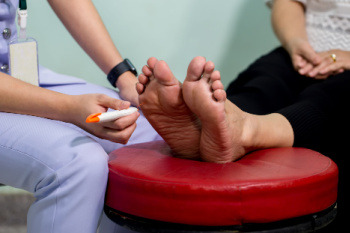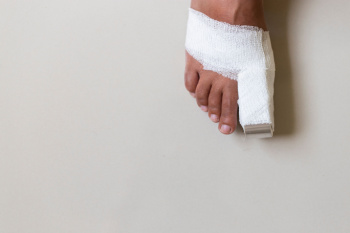Connect With Us
Blog
 Diabetic neuropathy is a complication of diabetes that occurs when high blood sugar levels cause damage to nerve fibers. The nerves in the legs and feet are primarily affected. This can lead to symptoms such as numbness, tingling, pain, and weakness in the affected areas. Patients typically have a difficult time feeling heat, cold, or pain. This reduced sensation increases the risk of injuries going unnoticed and becoming infected, potentially leading to severe complications. A podiatrist, or foot doctor, plays an important role in managing diabetic neuropathy by conducting regular foot examinations to monitor for potential injuries that patients may not detect themselves. They can also provide guidance on proper foot care practices, recommend suitable footwear to protect the feet, and promptly treat any foot problems, such as ulcers or infections. If you have neuropathy, it is suggested that you regularly consult a podiatrist to monitor any foot concerns.
Diabetic neuropathy is a complication of diabetes that occurs when high blood sugar levels cause damage to nerve fibers. The nerves in the legs and feet are primarily affected. This can lead to symptoms such as numbness, tingling, pain, and weakness in the affected areas. Patients typically have a difficult time feeling heat, cold, or pain. This reduced sensation increases the risk of injuries going unnoticed and becoming infected, potentially leading to severe complications. A podiatrist, or foot doctor, plays an important role in managing diabetic neuropathy by conducting regular foot examinations to monitor for potential injuries that patients may not detect themselves. They can also provide guidance on proper foot care practices, recommend suitable footwear to protect the feet, and promptly treat any foot problems, such as ulcers or infections. If you have neuropathy, it is suggested that you regularly consult a podiatrist to monitor any foot concerns.
Neuropathy
Neuropathy can be a potentially serious condition, especially if it is left undiagnosed. If you have any concerns that you may be experiencing nerve loss in your feet, consult with Afsha Naimat-Shahzad, DPM from Leander Foot & Ankle. Our doctor will assess your condition and provide you with quality foot and ankle treatment for neuropathy.
What Is Neuropathy?
Neuropathy is a condition that leads to damage to the nerves in the body. Peripheral neuropathy, or neuropathy that affects your peripheral nervous system, usually occurs in the feet. Neuropathy can be triggered by a number of different causes. Such causes include diabetes, infections, cancers, disorders, and toxic substances.
Symptoms of Neuropathy Include:
- Numbness
- Sensation loss
- Prickling and tingling sensations
- Throbbing, freezing, burning pains
- Muscle weakness
Those with diabetes are at serious risk due to being unable to feel an ulcer on their feet. Diabetics usually also suffer from poor blood circulation. This can lead to the wound not healing, infections occurring, and the limb may have to be amputated.
Treatment
To treat neuropathy in the foot, podiatrists will first diagnose the cause of the neuropathy. Figuring out the underlying cause of the neuropathy will allow the podiatrist to prescribe the best treatment, whether it be caused by diabetes, toxic substance exposure, infection, etc. If the nerve has not died, then it’s possible that sensation may be able to return to the foot.
Pain medication may be issued for pain. Electrical nerve stimulation can be used to stimulate nerves. If the neuropathy is caused from pressure on the nerves, then surgery may be necessary.
If you have any questions, please feel free to contact our office located in Leander, TX . We offer the newest diagnostic and treatment technologies for all your foot care needs.

Corns on the feet are small, yet bothersome, skin formations that can cause significant pain if left untreated. Foot corns, which are composed of layers of dead skin cells, typically appear as thick, circular, raised areas of skin. They commonly develop on, near, or between the toes, below the toenail bed, or on the sole of the feet. The three primary types of foot corns are hard corns, soft corns, and seed corns. Regardless of their type, foot corns can cause discomfort, pain, and a burning sensation, particularly when wearing shoes or walking barefoot. Foot corns develop from excessive pressure or friction on the foot. Causes include wearing tight or ill-fitting shoes, prolonged standing, and walking or running barefoot. It's a good idea to address foot corns promptly and effectively to prevent complications. A podiatrist can offer personalized treatment options, including professional corn removal techniques and recommendations for footwear modifications. If you are experiencing the discomfort of corns on the foot, it is suggested that you schedule an appointment with a podiatrist to determine the type of corn and its proper treatment.
Corns can make walking very painful and should be treated immediately. If you have questions regarding your feet and ankles, contact Afsha Naimat-Shahzad, DPM of Leander Foot & Ankle. Our doctor will treat your foot and ankle needs.
Corns: What Are They? And How Do You Get Rid of Them?
Corns are thickened areas on the skin that can become painful. They are caused by excessive pressure and friction on the skin. Corns press into the deeper layers of the skin and are usually round in shape.
Ways to Prevent Corns
There are many ways to get rid of painful corns such as:
- Wearing properly fitting shoes that have been measured by a professional
- Wearing shoes that are not sharply pointed or have high heels
- Wearing only shoes that offer support
Treating Corns
Although most corns slowly disappear when the friction or pressure stops, this isn’t always the case. Consult with your podiatrist to determine the best treatment option for your case of corns.
If you have any questions please feel free to contact our office located in Leander, TX . We offer the newest diagnostic and treatment technologies for all your foot and ankle needs.

A surgical procedure aimed at relieving pain from bone spurs on the top of the big toe is called a cheilectomy. The pain is the result of arthritis that also causes stiffness in the big toe, termed hallux rigidus. Typically considered after non-surgical interventions, a cheilectomy involves the careful removal of bone spurs to alleviate discomfort and improve range of motion. Whether performed under general or local anesthesia, the procedure usually allows for a same-day operation. Following surgery, treatment often starts with gentle toe movements and stretching exercises to prevent stiffness. The recovery period typically spans six to eight weeks. While individual recovery time may vary, the primary goal of restoring function and alleviating pain are the focus. If you have persistent pain and limited mobility in your big toe, it is suggested that you schedule an appointment with a podiatrist for an exam, diagnosis, and personalized treatment plan, which may include surgery.
Foot surgery is sometimes necessary to treat a foot ailment. To learn more, contact Afsha Naimat-Shahzad, DPM of Leander Foot & Ankle. Our doctor will assist you with all of your foot and ankle needs.
When Is Surgery Necessary?
Foot and ankle surgery is generally reserved for cases in which less invasive, conservative procedures have failed to alleviate the problem. Some of the cases in which surgery may be necessary include:
- Removing foot deformities like bunions and bone spurs
- Severe arthritis that has caused bone issues
- Cosmetic reconstruction
What Types of Surgery Are There?
The type of surgery you receive will depend on the nature of the problem you have. Some of the possible surgeries include:
- Bunionectomy for painful bunions
- Surgical fusion for realignment of bones
- Neuropathy decompression surgery to treat nerve damage
Benefits of Surgery
Although surgery is usually a last resort, it can provide more complete pain relief compared to non-surgical methods and may allow you to finally resume full activity.
Surgical techniques have also become increasingly sophisticated. Techniques like endoscopic surgery allow for smaller incisions and faster recovery times.
If you have any questions please feel free to contact our office located in Leander, TX . We offer the newest diagnostic and treatment technologies for all your foot and ankle needs.


